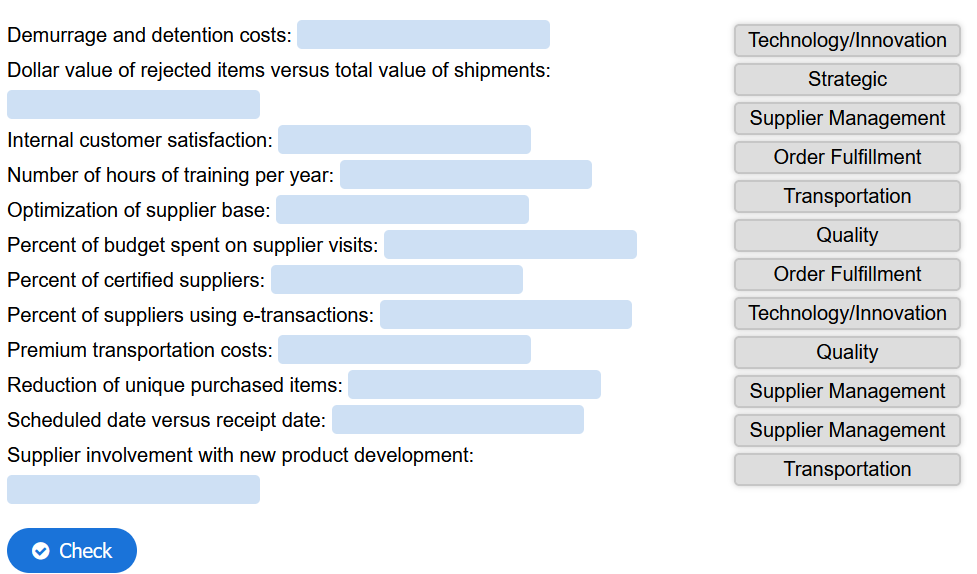The sole use of traditional financial and cost performance measures does not adequately reflect the performance of an organization or guarantee success. A measurement of processes is required in order to continuously improve and provide value for the customer.
Enter your text here…

Expand each of the following to learn more about some supply chain performance metrics, as well as other procurement metrics.
Order Fulfillment
Order Fulfillment metrics are a true measure of supply chain excellence and includes measurements for on-time delivery, and responsiveness.
- Time to market for new products – measures procurement’s ability to provide necessary components on time to achieve the new product introduction schedule
- On-time delivery – measures the percent of shipments or services meeting schedule requirements ◦ Request date versus actual ship date◦ Scheduled or promised due dates versus actual receipt dates◦ Tolerances for acceptable early or late arrivals for certain commodities◦ Quantities received versus ordered◦ Reductions in expediting activities and costs◦ Reductions in % of stockouts and shortages
- Cycle time reduction – metrics around purchase order processing times, transportation, etc.
- Responsiveness – a measurement of flexibility and agility for how the supply chain recognizes and responds to demand changes, design changes, problem resolution, etc.
- Internal customer satisfaction – satisfaction with purchasing’s ability to serve internal customers’ needs, communications, knowledge and capabilities
Logistics/Transportation
Logistics metrics are the reduction of costs associated with inbound transportation.
- Actual transportation costs vs. planned
- Demurrage and detention costs
- Total dollars spent on inbound transportation
- % of cost of goods sold or sales revenue
- Premium transportation $ or % of overall transportation cost
Quality
Quality metrics measure the conformance to requirements and the level of allowable defects.
- Six Sigma – Product quality and improvements based on PPM (parts per million)
- % and # of defects per supplier, by individual product as well as across all items supplied by that supplier, including tracking by type of defect
- Failure rates in the field – failure incidents once end product is in use by customer; measured by number of failures against total installed products
- Dollar value of rejected items versus total dollar value of shipments
- # of parts received versus number of parts rejected
- Dollars recovered from suppliers due to poor quality
- Warranty costs associated with supplier defects
- % of quality-certified suppliers to total # of suppliers
Supplier Management
Supplier management metrics measure procurement’s performance in managing supplier relationships.
- Spend visibility and analysis of suppliers, product categories, commodities, etc. to determine opportunities for savings and improvement
- Managing and developing local, regional, and global suppliers
- Furthering the integration and development of key suppliers
- Initiating supplier cost-reduction programs
- Maintaining and improving the quality of supplier relationships
- Optimizing the supply base to an appropriate number of suppliers
- Early supplier involvement in new product design
- % of budget committed to on-site supplier visits
- Supplier satisfaction measures
Technology and Innovation
Technology and innovation metrics measure how procurement uses technology to streamline the purchasing process.
- Use of e-procurement and e-transactions systems to minimize paper-based transactions ◦ % of suppliers and dollars using e-transactions◦ Dollar value and % of orders◦ % of ASN’s compared to total number of inbound shipments◦ Use of trading exchanges, electronic auctions and other B2B models
- Pull systems/shared schedules/vendor-managed inventory (VMI) ◦ # or % of suppliers with these types of purchasing relationship◦ $ of inventory spend managed this way
- Incorporation of new innovations ◦ number, frequency and dollar impact
- Use of demand-sensing technologies to analyze and translate demand patterns
- Standardization of components to reduce complexity ◦ Reduction of unique purchased items◦ % of new product products or services made up of current components◦ Number of industry-standard items used◦ Savings achieved from part number reductions and standardization
Risk Management
Risk management metrics include the identification, measurement, and mitigation of risks related to procurement activities, such as security of supply.
- Supplier financial risk
- Logistics disruption
- Supplier geographical disaster risks (e.g., typhoons, earthquakes)
- Political conditions
Strategic performance
Strategic performance metrics includes the ability of purchasing to support and contribute to overall corporate goals.
- Participating in/leading value analysis efforts
- Creating early supplier involvement initiatives
- Contributing to new product development efforts
- People development based on number of hours of training per year
- % of suppliers considered strategic
- % of dollars linked to long-term contracts
Exercise
Review your understanding of supply chain metrics by dragging and dropping the type of metric to the area of performance it measures.

